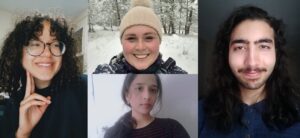Meet the EDISH Placements
As part of strand two of the Equality, Diversity & Inclusion in Scottish Heritage (EDISH) project, four work placements have been recruited into Scottish museums across the country to create templates for future EDI-focused placements run by heritage organisations.
We’re pleased to introduce to you the new placements and the work they have planned in their host museums.

Erin Turner (The Scottish Crannog Centre)
Erin is the EDISH placement at the Scottish Crannog Centre where her project, Iron Age Activist, looks at using Indigenous knowledge and methodologies at the Crannog Centre. She is Metis from the Algonquin and Mohawk nations of Eastern Canada.
Erin is currently working towards an MSc in Cultural Heritage at the University of Stirling. She previously obtained her BA in History and Anthropology from the University of Lethbridge in Canada. Her interests lie in how different cultures and peoples are perceived and presented by others, both currently and throughout history. She previously worked with women from marginalised Indigenous communities in Southern Alberta to foster wider representation in museums and to further recognise their roles in the history of their communities.
Q: What does inclusive Heritage look like to you?
Erin: To me, inclusive heritage means that all individuals, groups or cultures are able to contribute with fair and equal say and treatment.
Hope Moore (David Livingstone Birthplace)
Hope is the EDISH placement at the David Livingstone Birthplace Museum where she is producing learning resources for schools from the material found in the museum. She is from Sacramento, California, and this is her second year in Scotland.
Hope is pursuing a degree in History and Spanish at the University of Glasgow and is a Museum Student Educator (MuSE) at the Hunterian Museum. She has been studying Spanish for over six years. She has been a Spanish, History, English/Writing and Maths tutor since 2018, and her background in education has given her a good grounding in museum education. She has utilised her Spanish skills to work as a volunteer for the cultural community outreach organisation Friends of San Juan de Oriente, an international ambassador program that supports art, Indigenous culture and infrastructure development in Nicaragua. She also has experience coding in HTML. She is currently developing a new tour for the Hunterian entitled, ‘Indigenous Cultures and Exploration’.
Q: What does inclusive Heritage look like to you?
Hope: To me, inclusive heritage is making room.
Taweel Ali (Royal College of Physicians and Surgeons of Glasgow)
Taweel is the EDISH placement at the Royal College of Physicians and Surgeons of Glasgow where he is researching the first South Asian doctors who came to Glasgow in the 1870s to sit their licensee exams.
Taweel is a first year medical student at the University of Glasgow, where he has done research into the history of public health and medicine. He started learning Mandarin at university and has competed in the HSBC Mandarin speaking competition. He has spent time volunteering for ExCel London and at the University of Nottingham. He also has experience coding in HTML and python.
Q: What does inclusive Heritage look like to you?
Taweel: Inclusive heritage, to me, is the inclusion of the historical oppression and struggle of ethnic minorities in our current modern understanding of global history.
Yashasvi Jingar (HMS Unicorn)
Yashasvi is the EDISH placement at the HMS Unicorn where she is working on a project that focusses on the HMS Unicorn’s role in community life over the last 50 years, which will culminate in an exhibit of material relating to this topic.
Yashasvi recently completed her master’s in Cultural Heritage from the University of Aberdeen, and her bachelor’s degree is in Archaeology. For her master’s research project, she interned at Aberdeen Art Gallery and Museum as an Archaeology Collections Assistant, where her research focussed on the object study of medieval Aberdeen’s leather and textile collection and Curation Crisis. As part of her internship, she assisted the museum by creating best care and storage guidelines for the museum’s archaeology collection. She also researched the provenance of the Kildrummy gold brooch, the resulting research article of which was published in the Aberdeen Evening Express. She also has experience with archival research and museum collection management software. She is a remote volunteer at the Imperial War Museum, London, where she contributes to the War Memorial Database.
Q: What does inclusive Heritage look like to you?
Yashasvi: Inclusive heritage, in my understanding, is the initiative to include wider range of people in heritage.